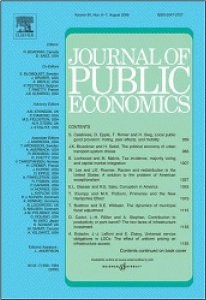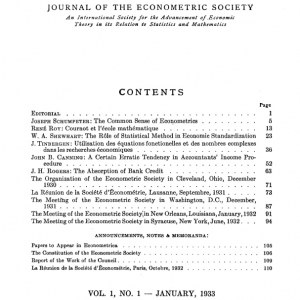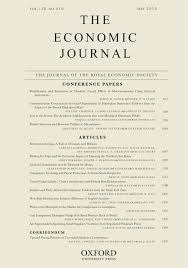

Peter Lanjouw
Key publications



List of publications
Garcia Rojas, D., Appelt, J.L., Epprecht, M., Kounnavong, S., Elbers, C., Lanjouw, P. and van Vliet, J. (2024). Interactions between sustainable development goals at the district level in Lao PDR World Development, 178:.
Rongen, G., Ahmad, Z.A., Lanjouw, P. and Simler, K. (2024). Regional and ethnic inequalities in Malaysian poverty dynamics Journal of Economic Inequality, 22(1):101--130.
van der Weide, R., Blankespoor, B., Elbers, C. and Lanjouw, P. (2024). How accurate is a poverty map based on remote sensing data? An application to Malawi Journal of Development Economics, 171:1--27.
Dang, HaiAnhH. and Lanjouw, PeterF. (2023). Measuring Poverty Dynamics with Synthetic Panels Based on Repeated Cross Sections Oxford Bulletin of Economics and Statistics, 85(3):599--622.
Elbers, C. and Lanjouw, P. (2023). The distributional impact of structural transformation in rural India: case-study evidence and model-based simulation Journal of Economic Inequality, 21(3):703--722.
Dang, H.A., Lanjouw, P. and Vrijburg, E. (2021). Poverty in India in the face of Covid-19: Diagnosis and prospects* Review of Development Economics, 25(4):1816--1837.
Garcés-Urzainqui, D., Lanjouw, P. and Rongen, G. (2021). Constructing synthetic panels for the purpose of studying poverty dynamics: A primer Review of Development Economics, 25(4):1803--1815.
Lanjouw, PeterF. and Tarp, F. (2021). Poverty, vulnerability and Covid-19: Introduction and overview Review of Development Economics, 25(4):1797--1802.
Dang, HaiAnhH. and Lanjouw, PeterF. (2018). Poverty dynamics in India between 2004 and 2012: Insights from longitudinal analysis using synthetic panel data Economic Development and Cultural Change, 67(1):131--170.
Lanjouw, P. and Marra, M.R. (2018). Urban poverty across the spectrum of Vietnam's towns and cities World Development, 110:295--306.
Dang, H. and Lanjouw, P. (2017). Welfare Dynamics Measurement: Two Definitions of a Vulnerability Line and Their Empirical Application The Review of Income and Wealth, 63(4):633--660.
Dang, H., Lanjouw, P. and Serajuddin, U. (2017). Updating poverty estimates in the absence of regular and comparable consumption data: methods and illustration with reference to a middle-income country Oxford Economic Papers, 69(4):939--962.
Cruces, G., Lanjouw, P., Lucchetti, L., Perova, E., Vakis, R. and Viollaz, M. (2015). Intra-Generational Mobility and Repeated Cross-Sections: A Three Country Validation Exercise Journal of Economic Inequality, 13(2):161--179.
Dang, H., Lanjouw, P., Luoto, J. and McKenzie, D. (2014). Using repeated cross-sections to explore movements into and out of poverty Journal of Development Economics, 107(March):112--128.
Himanshu, , Lanjouw, P., Murgai, R. and Stern, N. (2013). Nonfarm diversification, poverty, economic mobility, and income inequality: A case study in village India Agricultural Economics, 44(4-5):461--473.
Ferré, C., Ferreira, F.H.G. and Lanjouw, P. (2012). Is there a metropolitan bias? The relationship between poverty and city size in a selection of developing countries World Bank Economic Review, 26(3):351--382.
Christiaensen, L., Lanjouw, P., Luoto, J. and Stifel, D. (2012). Small area estimation-based prediction methods to track poverty: Validation and applications Journal of Economic Inequality, 10(2):267--297.
Lanjouw, P. and Rao, V. (2011). Revisiting Between-Group Inequality Measurement: An Application to the Dynamics of Caste Inequality in Two Indian Villages World Development, 39(2):174--187.
Lanjouw, P. and Murgai, R. (2009). Poverty decline, agricultural wages, and nonfarm employment in rural India: 1983-2004 Agricultural Economics, 40(2):243--263.
Araujo, M.Caridad, Ferreira, F.H.G., Lanjouw, P. and Özler, B. (2008). Local inequality and project choice: Theory and evidence from Ecuador Journal of Public Economics, 92(5-6):1022--1046.
Elbers, C., Lanjouw, P., Mistiaen, J. and Özler, B. (2008). Reinterpreting between-group inequality Journal of Economic Inequality, 6(3):231--245.
Elbers, C., Fujii, T., Lanjouw, P., Özler, B. and Yin, W. (2007). Poverty alleviation through geographic targeting: How much does disaggregation help? Journal of Development Economics, 83:198--213.
Elbers, C., Lanjouw, J.O.L. and Lanjouw, P. (2005). Imputed welfare estimates in regression analysis Journal of Economic Geography, 5(1):101--118.
Jayaraman, R. and Lanjouw, PeterF. (2004). Small-scale industry, environmental regulation, and poverty: The case of Brazil World Bank Economic Review, 18(3):443--464.
Elbers, C., Lanjouw, P., Mistiaen, J., Özler, B. and Simler, K. (2004). On the Unequal Inequality of Poor Communities World Bank Economic Review, 18(3):401--421.
Lanjouw, JeanO., Lanjouw, P., Milanovic, B. and Paternostro, S. (2004). Relative price shifts, economies of scale and poverty during economic transition Economics of Transition, 12(3):509--536.
Elbers, C., Lanjouw, J.O.L. and Lanjouw, P. (2003). Micro-Level Estimation of Poverty and Inequality Econometrica, 71(1):355--364.
Elbers, C. and Lanjouw, P. (2001). Intersectoral Transfer, Growth, and Inequality in Rural Ecuador World Development, 29(3):481--496.
Lanjouw, P., Quizon, J. and Sparrow, R. (2001). Non-Agricultural Earnings in Peri-Urban Areas of Tanzania: Evidence from Household Survey Data Food Policy, 26(4):385--404.
Lanjouw, P. (2001). Rural Nonfarm Employment and Poverty in El Salvador World Development, 29(3):529--547.
Ferreira, F. and Lanjouw, P. (2001). Rural Nonfarm Activities and Poverty in the Brazilian Northeast World Development, 29(3):509--528.
Lanjouw, J.O.L. and Lanjouw, P. (2001). The Rural Nonfarm Sector: Issues and Evidence from Developing Countries Agricultural Economics, 26:1--23.
Lanjouw, J.O.L. and Lanjouw, P. (2001). How to Compare Apples and Oranges: Poverty Measurement Based on Different Definitions of Consumption The Review of Income and Wealth, 47(1):25--42.
Hentschel, J., Lanjouw, J.O.L., Lanjouw, P. and Poggi, J. (2000). Combined Household Data with Census Data to Construct a Disaggregated Poverty Map: A Case Study of Ecuador World Bank Economic Review, 14(1 January):147--166.
Reardon, T., Taylor, J., Stamoulis, K., Lanjouw, P. and Balisacan, A. (2000). Effects of Non-Farm Employment on Rural Income Inequality in Developing Countries: an Investment Perspective Journal of Agricultural Economics, 54(2):266--288.
Lanjouw, P. and Ravallion, M. (1999). Benefit Incidence, Public Spending Reforms, and the Timing of Program Capture World Bank Economic Review, 13(2):257--273.
Jayaraman, R. and Lanjouw, P. (1999). The Evolution of Poverty and Inequality in Indian Villages World Bank Research Observer, 14(1):1--30.
Lanjouw, P. (1999). Rural Nonagricultural Employment and Poverty in Ecuador Economic Development and Cultural Change, 48(1):91--123.
Lanjouw, P. and Ravallion, M. (1995). Poverty and household size Economic Journal, 105(433):1415--1434.
Hussain, A., Lanjouw, P. and Stern, N. (1994). Income inequalities in China: Evidence from household survey data World Development, 22(12):1947--1957.
Lanjouw, P. and Stern, N. (1991). Poverty in Palanpur World Bank Economic Review, 5(1):23--55.